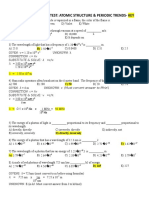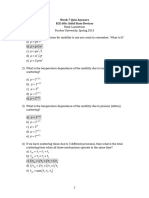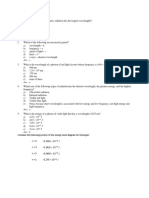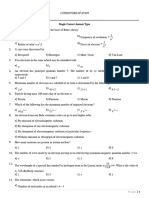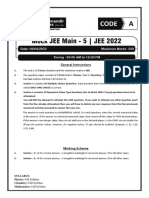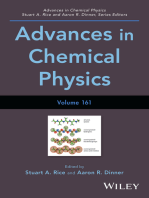0 ratings0% found this document useful (0 votes)
48 viewsLaser Midterm Test 2021 - Answer Sheet
Laser Midterm Test 2021 - Answer Sheet
Uploaded by
Mahmoud AnwerThis document contains a 10 question multiple choice midterm exam on laser physics. The midterm covers topics like the unique properties of lasers, definitions of masers, relations between Einstein's coefficients, processes involved in optical pumping, and units of coefficients. It provides the context of being a second semester exam from Zagazig University's Physics Department in Egypt.
Copyright:
© All Rights Reserved
Available Formats
Download as PDF, TXT or read online from Scribd
Laser Midterm Test 2021 - Answer Sheet
Laser Midterm Test 2021 - Answer Sheet
Uploaded by
Mahmoud Anwer0 ratings0% found this document useful (0 votes)
48 views1 pageThis document contains a 10 question multiple choice midterm exam on laser physics. The midterm covers topics like the unique properties of lasers, definitions of masers, relations between Einstein's coefficients, processes involved in optical pumping, and units of coefficients. It provides the context of being a second semester exam from Zagazig University's Physics Department in Egypt.
Original Title
Laser Midterm Test 2021_Answer Sheet
Copyright
© © All Rights Reserved
Available Formats
PDF, TXT or read online from Scribd
Share this document
Did you find this document useful?
Is this content inappropriate?
This document contains a 10 question multiple choice midterm exam on laser physics. The midterm covers topics like the unique properties of lasers, definitions of masers, relations between Einstein's coefficients, processes involved in optical pumping, and units of coefficients. It provides the context of being a second semester exam from Zagazig University's Physics Department in Egypt.
Copyright:
© All Rights Reserved
Available Formats
Download as PDF, TXT or read online from Scribd
Download as pdf or txt
0 ratings0% found this document useful (0 votes)
48 views1 pageLaser Midterm Test 2021 - Answer Sheet
Laser Midterm Test 2021 - Answer Sheet
Uploaded by
Mahmoud AnwerThis document contains a 10 question multiple choice midterm exam on laser physics. The midterm covers topics like the unique properties of lasers, definitions of masers, relations between Einstein's coefficients, processes involved in optical pumping, and units of coefficients. It provides the context of being a second semester exam from Zagazig University's Physics Department in Egypt.
Copyright:
© All Rights Reserved
Available Formats
Download as PDF, TXT or read online from Scribd
Download as pdf or txt
You are on page 1of 1
Zagazig University Laser Physics
Faculty of Science Fouth year
Physics Department 26 / 05 / 2021
Second Semester 2020/2021 Time: 30 min.
Midterm Marks: 10 degree
:المس ـ ـ ـتـوى :اس ـ ـ ـ ـ ــم الطالب
:الشعب ـ ـ ـ ــة :الرقم الجامعي
Answer All the Questions
MULTI CHOICE QUESTIONS (10 point):
1. Which of the following is a unique property of laser?
a) Deviation b) Speed
c) Coherence d) Wavelength
2. The maser is defined as a ……….. ……….. by stimulated emission of radiation.
a) Light amplification b) Methylene amplification
c) Microwave amplification d) None of the previous answer
3. The ratio of N2 and N1 is given by _________.
hν/kT
a) 𝑒 b) 𝒆-h𝛎/kT
c) 𝑒 -hν/T d) 𝑒 hν/T
4. At the state when N1 > N2, the intensity of light wave _________.
a) Decreases exponentially b) Increases exponentially
c) Decreases linearly d) Increases linearly
5. Which of the following is the correct expression for the relation between Einstein’s coefficients
A21 and B21?
2 3
a) 8πhν ⁄c 2 b) 8πhc ⁄ν3
3
c) 8πhc ⁄λ3 d) 8 πh⁄λ3
6. The correct expression for the rate of stimulated emission is _______________.
a) R se = A21ρν N2 b) R se = A21N2
c) R se = B12ρν N2 d) None of the previous answer
7. Which law is used for achieving the relation between the Einstein’s coefficients?
a) Planck’s radiation law b) Einstein’s equation
c) Heisenberg’s Uncertainty Principle d) Quantum law
8. Optical pumping happens via ___________.
a) Stimulated emission b) Stimulated absorption
c) Spontaneous emission d) Spontaneous absorption
9. Pumping is done in order to achieve __________
a) Equilibrium b) Steady state
c) Population inversion d) Photon emission
10. What is the unit of the coefficient of spontaneous emission?
a) J b) J -1
c) s d) s -1
With my best regards
You might also like
- Transient Recovery Voltage (TRV) StudiesDocument30 pagesTransient Recovery Voltage (TRV) Studiesaqaish15No ratings yet
- Edexcel IAL Physics Lab BookDocument30 pagesEdexcel IAL Physics Lab BookGazar61% (18)
- Physics 12 STD Volume 2 70 MarksDocument5 pagesPhysics 12 STD Volume 2 70 Markshemakris2003No ratings yet
- Chapter 7 Practice Test AtomStrctrPeriodicTrend GOOD-KEY1Document5 pagesChapter 7 Practice Test AtomStrctrPeriodicTrend GOOD-KEY1Senthereng MoaisiNo ratings yet
- Chemistry-I 1ST QTR PDFDocument2 pagesChemistry-I 1ST QTR PDFAtharrizwanNo ratings yet
- C1100e TDDocument27 pagesC1100e TDghadirtaleb4No ratings yet
- Phy XDocument4 pagesPhy XMuhammad SaadNo ratings yet
- XII PHYSICSDocument4 pagesXII PHYSICSmitthunlalkNo ratings yet
- Questiions NewwDocument17 pagesQuestiions NewwAnirudha PraveenNo ratings yet
- Class 12 Sample Paper With Solution Physics Set 3Document11 pagesClass 12 Sample Paper With Solution Physics Set 3veena334287No ratings yet
- Week7Quiz AnswersDocument4 pagesWeek7Quiz AnswersChin AliciaNo ratings yet
- Structure of Atom DPP 1Document3 pagesStructure of Atom DPP 1mrastro0007No ratings yet
- A03. Mcat Uhs Past Paper 2010 - PinkDocument18 pagesA03. Mcat Uhs Past Paper 2010 - PinkMoonNo ratings yet
- h λ h λ nh λ λ: t t= t t= tDocument2 pagesh λ h λ nh λ λ: t t= t t= tMuhammad Hassan MaqsoodNo ratings yet
- Final Exam ReviewModern Physics 1528318833428 TCDocument24 pagesFinal Exam ReviewModern Physics 1528318833428 TCFrans BorokoNo ratings yet
- RSC Starter for Ten - 10. AnalysisDocument9 pagesRSC Starter for Ten - 10. Analysisaw15014102800No ratings yet
- Test 4Document13 pagesTest 4AbhishekNo ratings yet
- PHYSICS (Theory) - (02-03-2020) - SolDocument25 pagesPHYSICS (Theory) - (02-03-2020) - SolakramahussirNo ratings yet
- Review - 2018 - Final ExamDocument3 pagesReview - 2018 - Final ExamQuang LinhNo ratings yet
- Model Vite Ee 2020Document6 pagesModel Vite Ee 2020Swaroop BijuNo ratings yet
- AP2 Ch22 PracticeDocument3 pagesAP2 Ch22 Practicevidushibhandari22No ratings yet
- Physics 1Document161 pagesPhysics 1Muskan PooniaNo ratings yet
- XII-PHY-SEMI-PRELIM-PAPER - I (24-25) 01.12.2024Document34 pagesXII-PHY-SEMI-PRELIM-PAPER - I (24-25) 01.12.2024abdul696988No ratings yet
- Btech 1 Sem Physics Kas101 2022Document2 pagesBtech 1 Sem Physics Kas101 2022Neelam SinghNo ratings yet
- Atomic Structure ReviewDocument7 pagesAtomic Structure ReviewKinal PatelNo ratings yet
- P102 Fin Sum 18Document4 pagesP102 Fin Sum 18Shadi AlnaanahNo ratings yet
- Practice Questions For Ch. 7: Identify The Choice That Best Completes The Statement or Answers The QuestionDocument26 pagesPractice Questions For Ch. 7: Identify The Choice That Best Completes The Statement or Answers The QuestionPaolo PepsNo ratings yet
- Reg. No.: Name:: Q.No. Sub. Sec. Question Description MarksDocument2 pagesReg. No.: Name:: Q.No. Sub. Sec. Question Description MarksLaxmitej ManchikantiNo ratings yet
- 3.2.2.4 Wave Particle Duality 547452Document56 pages3.2.2.4 Wave Particle Duality 547452David HolmesNo ratings yet
- Model Question Paper HP Board of School Education Dharamshala Term - II Session: 2021-22 Subject: Physics Class: XII (Regular)Document5 pagesModel Question Paper HP Board of School Education Dharamshala Term - II Session: 2021-22 Subject: Physics Class: XII (Regular)Jack DourNo ratings yet
- Physics, (PH 1007)Document8 pagesPhysics, (PH 1007)2004181No ratings yet
- Xii-Board 3RD 33% Physics QP - 18.11.2023Document7 pagesXii-Board 3RD 33% Physics QP - 18.11.2023eashwarsiddhaNo ratings yet
- Learnac: Mht-Cet 2020Document2 pagesLearnac: Mht-Cet 2020Ajuba AbujaNo ratings yet
- Btech 1 Sem Engineering Physics 1 Ras101 2022Document2 pagesBtech 1 Sem Engineering Physics 1 Ras101 2022Rashmi BishtNo ratings yet
- MCQ Test-4, Unit 2, Engg - Chemistry, 2020-21Document10 pagesMCQ Test-4, Unit 2, Engg - Chemistry, 2020-21Dr. N. P. Tripathi100% (1)
- 12th Physics 2nd Half Syllabus Test 19-NovDocument6 pages12th Physics 2nd Half Syllabus Test 19-NovSaurabhNo ratings yet
- Xii Third 33% PhysicsDocument5 pagesXii Third 33% Physicshotah61811No ratings yet
- Phy Test 3Document6 pagesPhy Test 3ashokpdrpNo ratings yet
- Unit 4 MCQ Phy110Document53 pagesUnit 4 MCQ Phy110Bla bla HeroNo ratings yet
- WB JEE Master Question Bank Chapter Wise PC-20210707093717556734Document51 pagesWB JEE Master Question Bank Chapter Wise PC-20210707093717556734PRIYANSHNo ratings yet
- Structure of Atom-1Document126 pagesStructure of Atom-1mohdhashim8789No ratings yet
- Laser MCQDocument3 pagesLaser MCQKushal BhattNo ratings yet
- Admission Test Sample PhyDocument10 pagesAdmission Test Sample PhyFatima Yasir QureshiNo ratings yet
- GT_05_Q.P_WITH_SOLS_06-01-2025Document26 pagesGT_05_Q.P_WITH_SOLS_06-01-2025babecanikissu7No ratings yet
- MCQ's Chap 19Document3 pagesMCQ's Chap 19Arham MunirNo ratings yet
- Dual Nature of Radiation and Matter Dpp7Document3 pagesDual Nature of Radiation and Matter Dpp7gauravyadav141998No ratings yet
- OXFORD SCHOOL 12th PreBoardDocument4 pagesOXFORD SCHOOL 12th PreBoardccajjrNo ratings yet
- 22.11.2024- 12th Physics-Vol-3- OKDocument5 pages22.11.2024- 12th Physics-Vol-3- OKbkss238896No ratings yet
- Physics 12 Volume 70 Marks - IIDocument6 pagesPhysics 12 Volume 70 Marks - IIhemakris2003No ratings yet
- Engineering Physics June 2013 (2010)Document4 pagesEngineering Physics June 2013 (2010)Prasad C MNo ratings yet
- QP MSC Nanotech 30012020Document29 pagesQP MSC Nanotech 30012020Dr. B. Sree Giri PrasadNo ratings yet
- Cbse past year question paper (1)Document8 pagesCbse past year question paper (1)shivanshichauhan011No ratings yet
- Cblephpl 06Document6 pagesCblephpl 06Harishni ArulvasagamNo ratings yet
- Basic Science (22102) Question BankDocument4 pagesBasic Science (22102) Question BankSatish Edake100% (1)
- Assignment 8 _ Chapter 6withQNDocument8 pagesAssignment 8 _ Chapter 6withQNshanakaNo ratings yet
- Ch29 Giancoli7e TestBankDocument6 pagesCh29 Giancoli7e TestBankGhazi DallyNo ratings yet
- cblephpu17Document8 pagescblephpu17shivaidnewNo ratings yet
- Assessment Physics PaperDocument6 pagesAssessment Physics PaperPradeesh GNo ratings yet
- Secondary 4 / Grade 10 & 11: Full Name: Index NumberDocument15 pagesSecondary 4 / Grade 10 & 11: Full Name: Index Numberkusniar deny permanaNo ratings yet
- 2022 Mock JEE Main-5 - PaperDocument15 pages2022 Mock JEE Main-5 - PaperAshish GuleriaNo ratings yet
- PHY Test3Document6 pagesPHY Test3ashokpdrpNo ratings yet
- II PUC Physics-QB-24-25-1 (1)Document22 pagesII PUC Physics-QB-24-25-1 (1)v.vizzy008No ratings yet
- Pump Seal Failure RelayDocument4 pagesPump Seal Failure RelaymahumboNo ratings yet
- Three-Dimensional Numerical Analyses On Liquid-Metal Magnetohydrodynamic Flow Through Circular Pipe in Magnetic-Field Outlet-RegionDocument18 pagesThree-Dimensional Numerical Analyses On Liquid-Metal Magnetohydrodynamic Flow Through Circular Pipe in Magnetic-Field Outlet-RegionabdullaalakourNo ratings yet
- Physics SummativeDocument4 pagesPhysics SummativeAerian BonifacioNo ratings yet
- Physics 2Document2 pagesPhysics 2Elyse FallarmeNo ratings yet
- 3 Chapter Exercise - eDocument6 pages3 Chapter Exercise - eHebeNo ratings yet
- Optics PolarizationDocument16 pagesOptics PolarizationMuhammad Farid ShahidNo ratings yet
- 12th Physics EM Public Exam 2023 Frequently Asked Questions Sura Guide English Medium PDF DownloadDocument6 pages12th Physics EM Public Exam 2023 Frequently Asked Questions Sura Guide English Medium PDF Downloadsumathimanoharan72496No ratings yet
- Electrical FormulasDocument10 pagesElectrical Formulasvijay babu100% (1)
- Nivoradar: Continuous Level Measuring System Technical Information / Instruction ManualDocument25 pagesNivoradar: Continuous Level Measuring System Technical Information / Instruction ManualDavid SarccoNo ratings yet
- Chapter - 15 Some Natural Phenomena (Revision Notes) : LightningDocument13 pagesChapter - 15 Some Natural Phenomena (Revision Notes) : LightningShivang GuptaNo ratings yet
- Kami Export - Aljawharah Alqahtani - Circuit LabDocument6 pagesKami Export - Aljawharah Alqahtani - Circuit LabAljawharah AlqahtaniNo ratings yet
- Polarons and Bipolarons: An Introduction 1st Edition Ashok Chatterjee (Author) 2024 Scribd DownloadDocument47 pagesPolarons and Bipolarons: An Introduction 1st Edition Ashok Chatterjee (Author) 2024 Scribd Downloadraczneokunor100% (4)
- D9 Electric Potential Voltage Worksheet PDFDocument2 pagesD9 Electric Potential Voltage Worksheet PDFJaja TrabajadaNo ratings yet
- Proximity - IGT205 - IFMDocument3 pagesProximity - IGT205 - IFMPhượng NguyễnNo ratings yet
- BTECH - CopyDocument40 pagesBTECH - Copysujalbarnwal2005No ratings yet
- New Microsoft Word DocumentDocument5 pagesNew Microsoft Word DocumentShivas RegalNo ratings yet
- BK12HK C511e006aDocument2 pagesBK12HK C511e006aKomal Sona SharmaNo ratings yet
- Diagrama 318-D2 PDFDocument16 pagesDiagrama 318-D2 PDFDaniel Rosales ReyesNo ratings yet
- Physics Project 2nd TermDocument5 pagesPhysics Project 2nd TermMohammad DyabNo ratings yet
- Energy Band Theory in SolidsDocument3 pagesEnergy Band Theory in Solidsashok pradhanNo ratings yet
- June 2018 QP - Component 2 WJEC Physics AS-levelDocument15 pagesJune 2018 QP - Component 2 WJEC Physics AS-levelfadi baqainNo ratings yet
- Physics Remedial QuestionsDocument6 pagesPhysics Remedial QuestionsRupa BalasubramanianNo ratings yet
- Magnetostatic Boundary ConditionsDocument9 pagesMagnetostatic Boundary ConditionsDIEGO ALEJANDRO PRIETO OSORIONo ratings yet
- Two-Agent Formation Control of Magnetic Microrobots: July 2016Document7 pagesTwo-Agent Formation Control of Magnetic Microrobots: July 2016mezianeNo ratings yet
- Insert: Ems and Jib Parts ManualDocument74 pagesInsert: Ems and Jib Parts Manualmauricio carmonaNo ratings yet
- Particle & NuclearDocument37 pagesParticle & NuclearIzzah ZahidNo ratings yet
- (Mkhitaryan2021) Can Copper Nanostructures Sustain High-Quality PlasmonsDocument9 pages(Mkhitaryan2021) Can Copper Nanostructures Sustain High-Quality PlasmonsspinbrionesNo ratings yet



